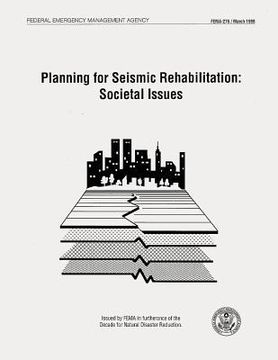Synopsis "Planning for Seismic Rehabilitation: Societal Issues (FEMA 275) (in English)"
In 1984, the Federal Emergency Management Agency (FEMA) initiated a comprehensive, and closely coordinated program to develop a body of knowledge in support of building practices that would increase the ability of existing buildings to withstand the forces of earthquakes. Societal issues inherent in seismic rehabilitation processes also have received attention. At a cumulative cost of about $26million, this FEMA effort has generated two dozen publications and a number of software programs and audio-visual training materials for use by design professionals, building regulatory personnel, educators, researchers, and the general public. The program has proceeded along separate but parallel approaches in dealing with both private sector and federal buildings. Already available from FEMA to private sector practitioners and other interested parties is a "technical platform" of consensus criteria on how to deal with some of the major engineering aspects of the seismic rehabilitation of buildings. This technical material comprises a trilogy with supporting documentation: a method for the rapid identification of buildings that might be hazardous in an earthquake and which can be conducted without gaining access to the buildings themselves; a methodology for a more detailed evaluation of a building that identifies structural flaws that have caused collapse in past earthquakes and might do so again in future earthquakes, and a compendium of the most commonly used techniques of seismic rehabilitation. Along with this volume, the culminating activity in the field of seismic rehabilitation is the completion of a comprehensive set of nationally applicable guidelines with commentary on how to rehabilitate buildings so that they will better withstand earthquakes. Known as the AEJRP Guidelines for the Seismic Rehabilitation of Buildings (FEMA 273) and the Commentary on the Guidelines for the Seismic Rehabilitation of Buildings (FEMA 274), these volumes, the results of a multiyear, multimillion dollar effort, represent a first of its kind in the United States. The Guidelines allow practitioners to choose design approaches consistent with different levels of seismic safety as required by geographic location, performance objective, type of building, use or occupancy, or other relevant considerations. The Guidelines documents also include analytical techniques that will assist in generating reliable estimates of the expected earthquake performance of rehabilitated buildings. This extensive platform of materials fills a significant gap in that portion of the National Earthquake Hazards Reduction Program (NEHRP) focusing on the seismic safety of existing buildings. It is expected that, with time, the Guidelines will be referenced or adapted by standards-setting groups and model building code organizations and will thereby diffuse widely into building practices across the United States. This volume complements the technical materials principally oriented to design professionals in the Guidelines documents. Because of the complexities and possible disruption caused by seismic rehabilitation projects, this volume's title, Planning for Seismic Rehabilitation: Societal Issues, calls attention to two important themes: that careful planning can minimize possibly difficult societal problems and that there exists a wide range of societal issues that maybe more significant in rehabilitation projects than in new construction. In many ways, this publication is intended to provide a "heads up" to those who are considering individual or multiple building, construction class or use, or area-focused seismic rehabilitation efforts.

